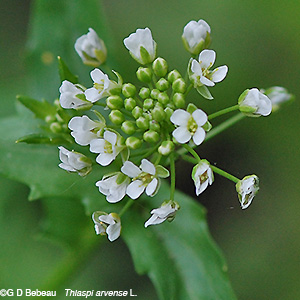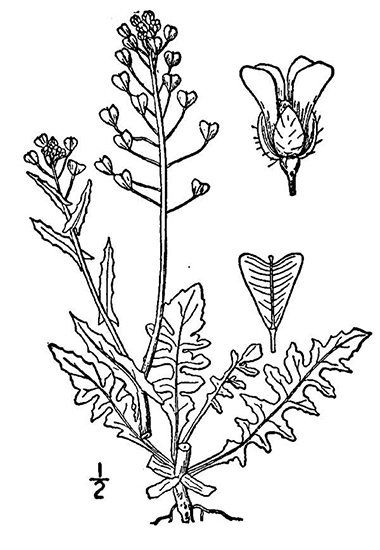The Friends of the Wildflower Garden, Inc.
Invasive Plants in Minnesota
The Eloise Butler Wildflower Garden is the oldest public wildflower garden in the United States

Common Name
Field Pennycress (Fanweed, Stinkweed)
Scientific Name
Thlaspi arvense L.
Plant Family
Mustard (Brassicaceae)
Garden Location
Not located in the Garden
Prime Season
Spring to Early Summer Flowering
Field Pennycress is an introduced erect annual forb growing from 4 to 20+ inches high on hairless flowering stems, without branching or only a very little near the top. Plants that germinate from seed in the late summer will form a winter rosette and the flowering stem the next spring. Stems are ribbed and sometimes with small wings.
The leaves are of two types. Basal leaves are oblanceolate, that is, taper to a pointed base resembling a stalk, are longer than wide and broadest above the middle. The blade is oblong with the margin smooth or with some marginal wavy indentations; the tip is rounded. Stem leaves are oblong, stalkless and clasping with an auricled base. These auricles have a blunt arrow shaped point at the base. Upper leaves have margins with coarse rounded to pointed teeth. The basal leaves drop away early.
The inflorescence is a cluster (a raceme) of stalked flower buds, somewhat flat-topped, that occurs at the top of the main stem and any side stems rising from the leaf axils. As flowers open from the base of the cluster, the cluster elongates and flower opening proceeds upward.
The flowers are 4-parted with a calyx of 4 green sepals and the corolla has 4 white petals that are 2x as long as the sepals and narrow to a claw-like base. Each flower is only 1/8 inch wide blooming first from the lower section of the raceme, which then elongates as more flowers come into bloom and older flowers produce seed. Flowers are held by short stalks that curve upward slightly. The stamens are slightly tetradynamous, that is, in two sets, 4 around the greenish pistil and two shorter lateral stamens that have a pair of nectar glands at their base. This is typical in the Mustard family. Anthers are yellow; the pistil has a blunt flattened tip to the stigma.
Seed: Mature flowers produce a rounded 2-celled 1/2 inch wide seed pod that is very flat and broadly winged all around with a notch at the apex that is deeper than it is wide. These pods are held erect to the flower raceme at the end of the old flower stalk and when dry are blown off by the wind. The pod splits down the middle releasing seeds from each cell. Individual seeds are slightly flattened ovals with concentric striations, turning from dark reddish brown in color to blackish-brown.
Habitat: Field Pennycress germinates its seed in waste places and disturbed areas. It blooms early, needs moderate moisture and will tolerate partial shade.
Names: The genus Thlaspi is from the Greek word for a cress, coming from the word thalo which means 'to compress' referring to the flattened seeds. The species arvense means 'growing in fields' where this plant might typically be found as the common name implies. 'Pennycress' is therefore derived from the flattened seed shape, as wide as a penny, as is the alternate common name of 'Fanweed' - the seeds on their stalks look like little hand-held fans. The flowers are not aromatic but the crushed foliage will have a rank, garlic like odor, hence "Stinkweed." The author name for the plant classification, 'L.' is for Carl Linnaeus (1707-1778), Swedish botanist and the developer of the binomial nomenclature of modern taxonomy.
Comparisons: Two plants may confuse with this species: First is Pepper Grass, Lepidium densiflorum, but there while the seed pods are similar, the leaves do not clasp and the flower petals are shorter than the sepals. Second is Shepherd's Purse, Capsella bursa-pastoris. There the seed pods are triangular without wings, but the upper leaves are similar with auricles; the flowers are also similar but with the sepals colored more pinkish at flowering time. Comparison drawings are show below.


Above: A plant with the inflorescence in the flowering stage but no seed capsules yet formed. Drawing from Britton, N.L., and A. Brown. 1913. An illustrated flora of the northern United States, Canada and the British Possessions. 3 vols. Charles Scribner's Sons, New York.
Below: The small flowers have 4 green sepals and 4 longer white petals. Of the 6 stamens, 2 are shorter with nectar glands at the base.


Below: 1st photo - The flowering stem has little branching but multiple flower clusters may rise from the upper leaf axils. 2nd photo - Stem leaves have blunt upward pointed teeth and are stalkless or with an auricle that clasps the ridged stem. 3rd photo - Seed pods are very flat and broadly winged all around with a notch at the apex that is deeper than wide.



Below: 1st photo - The auricles of stem leaves have a blunt point at the base. 2nd photo - The basal leaves are oblanceolate with wavy edges and rounded tips.


Below: 1st photo - A basal rosette in spring before the flowing stems rise. This was formed the prior year. 2nd & 3rd photos - Detail of the ridged stem and a young leaf that has the clasping auricle but without fully developed teeth on the margins.



Below - Seeds: 1st photo - Each seed pod is in 2 chambers that split down the middle releasing seeds from each half. 2nd photo - Seeds are flattened ovals, dark blackish-brown, with concentric striations. 3rd photo - Mature plants carry many of these seed pods when they mature in mid-summer.




Below: Comparison drawings of Pepper Grass (1st drawing) and Shepherd's Purse (2nd drawing); both drawings from Britton, N.L., and A. Brown. 1913. An illustrated flora of the northern United States, Canada and the British Possessions. 3 vols. Charles Scribner's Sons, New York.


Notes: Field Pennycress is a native of Eurasia that is now found throughout North America. It is found in many counties of Minnesota throughout the state having first been collected in Goodhue County in 1883. It is on the Minnesota Restricted Species List.
It is injurious to cattle in that the chemicals in the weed produce tainted milk in cows. Because of the aromatics most browsers avoid the plant.
Return to -- Site Plan/Archive Index --or-- List of Common Plant Names -- or -- List of Scientific Names -- or --Home Page - - - Back to top.
References: Plant characteristics are generally from sources 1A, 32, W2, W3, W7 & W8 plus others as specifically applied. Distribution principally from W1, W2 and 28C. Planting history generally from 1, 4 & 4a. Other sources by specific reference. See Reference List for details.
 Identification booklet for most of the flowering forbs and small flowering shrubs of the Eloise Butler Wildflower Garden. Details Here.
Identification booklet for most of the flowering forbs and small flowering shrubs of the Eloise Butler Wildflower Garden. Details Here.
©2014
Friends of the Wildflower Garden, Inc. Text and photos are by G. D. Bebeau unless otherwise credited. "www.friendsofeloisebutler.org"
011223